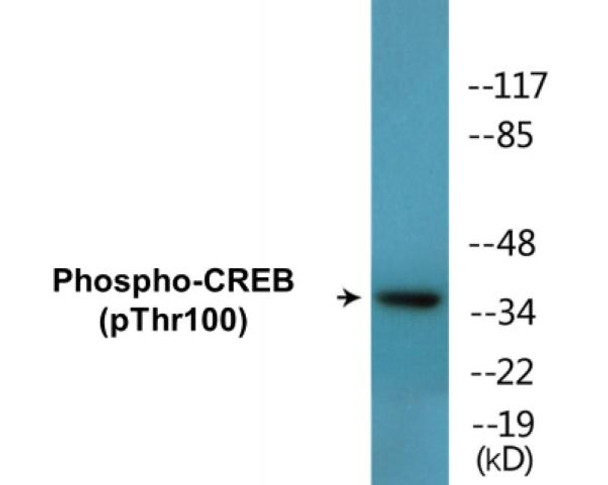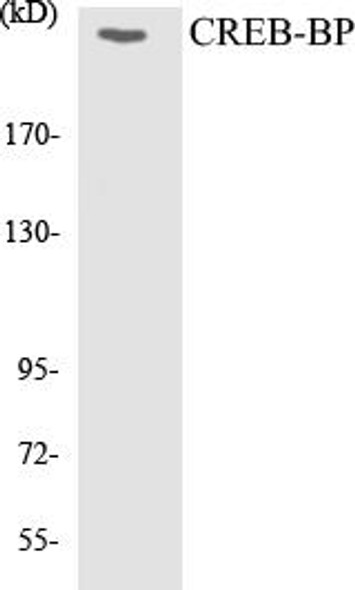Description
CREB (Phospho-Thr100)Colorimetric Cell-Based ELISA Kit
The CREB (cAMP Response Element-Binding protein) Phospho-Thr100 Colorimetric Cell-Based ELISA Kit is a cutting-edge product designed for the precise measurement of phosphorylated CREB at Thr100 levels in cell lysates. This innovative kit offers exceptional sensitivity and accuracy for the reliable and reproducible quantification of intracellular signaling pathways.CREB is a vital transcription factor that plays a key role in processes such as neuronal plasticity, memory formation, and cell survival. Phosphorylation of CREB at Thr100 is known to regulate gene expression and influence cellular responses to various stimuli.
Dysregulation of this pathway has been linked to a range of diseases, including neurological disorders, cancer, and metabolic disorders.With the CREB Phospho-Thr100 Colorimetric Cell-Based ELISA Kit, researchers can easily and efficiently study the role of phosphorylated CREB in cell signaling and disease pathology. This kit is a valuable tool for advancing research in biological and biomedical fields, providing crucial insights into the molecular mechanisms underlying complex cellular processes.
| Product Name: | CREB (Phospho-Thr100) Colorimetric Cell-Based ELISA |
| Product Code: | CBCAB01623 |
| ELISA Type: | Cell-Based |
| Target: | CREB (Phospho-Thr100) |
| Reactivity: | Human, Mouse, Rat |
| Dynamic Range: | > 5000 Cells |
| Detection Method: | Colorimetric 450 nm |
| Format: | 2 x 96-Well Microplates |
The CREB (Phospho-Thr100) Colorimetric Cell-Based ELISA Kit is a convenient, lysate-free, high throughput and sensitive assay kit that can detect CREB protein phosphorylation and expression profile in cells. The kit can be used for measuring the relative amounts of phosphorylated CREB in cultured cells as well as screening for the effects that various treatments, inhibitors (ie. siRNA or chemicals), or activators have on CREB phosphorylation.
Qualitative determination of CREB (Phospho-Thr100) concentration is achieved by an indirect ELISA format. In essence, CREB (Phospho-Thr100) is captured by CREB (Phospho-Thr100)-specific primary (1ø) antibodies while the HRP-conjugated secondary (2ø) antibodies bind the Fc region of the 1ø antibody. Through this binding, the HRP enzyme conjugated to the 2ø antibody can catalyze a colorimetric reaction upon substrate addition. Due to the qualitative nature of the Cell-Based ELISA, multiple normalization methods are needed:
| 1. | A monoclonal antibody specific for human GAPDH is included to serve as an internal positive control in normalizing the target absorbance values. |
| 2. | Following the colorimetric measurement of HRP activity via substrate addition, the Crystal Violet whole-cell staining method may be used to determine cell density. After staining, the results can be analysed by normalizing the absorbance values to cell amounts, by which the plating difference can be adjusted. |
| Database Information: | Gene ID: 1385, UniProt ID: P16220, OMIM: 123810/612160, Unigene: Hs.516646/Hs.584750 |
| Gene Symbol: | CREB1 |
| Sub Type: | Phospho |
| UniProt Protein Function: | Function: This protein binds the cAMP response element (CRE), a sequence present in many viral and cellular promoters. CREB stimulates transcription on binding to the CRE. Transcription activation is enhanced by the TORC coactivators which act independently of Ser-133 phosphorylation. Implicated in synchronization of circadian rhythmicity. |
| UniProt Protein Details: | Subunit structure: Interacts with PPRC1. Binds DNA as a dimer. This dimer is stabilized by magnesium ions. Interacts, through the bZIP domain, with the coactivators TORC1/CRTC1, TORC2/CRTC2 and TORC3/CRTC3. When phosphorylated on Ser-133, binds CREBBP By similarity. Interacts (phosporylated form) with TOX3. Interacts with ARRB1. Ref.8 Ref.9 Ref.11 Ref.13 Ref.14 Ref.15 Ref.16 Ref.20 Subcellular location: Nucleus Ref.12. Post-translational modification: Stimulated by phosphorylation. Phosphorylation of both Ser-133 and Ser-142 in the SCN regulates the activity of CREB and participates in circadian rhythm generation. Phosphorylation of Ser-133 allows CREBBP binding By similarity. Phosphorylated upon DNA damage, probably by ATM or ATR. Ref.10 Ref.17 Ref.19Sumoylated by SUMO1. Sumoylation on Lys-304, but not on Lys-285, is required for nuclear localization of this protein. Sumoylation is enhanced under hypoxia, promoting nuclear localization and stabilization. Ref.12 Involvement in Disease: Defects in CREB1 may be a cause of angiomatoid fibrous histiocytoma (AFH) [ MIM:612160]. A distinct variant of malignant fibrous histiocytoma that typically occurs in children and adolescents and is manifest by nodular subcutaneous growth. Characteristic microscopic features include lobulated sheets of histiocyte-like cells intimately associated with areas of hemorrhage and cystic pseudovascular spaces, as well as a striking cuffing of inflammatory cells, mimicking a lymph node metastasis. Note=A chromosomal aberration involving CREB1 is found in a patient with angiomatoid fibrous histiocytoma. Translocation t(2;22)(q33;q12) with CREB1 generates a EWSR1/CREB1 fusion gene that is most common genetic abnormality in this tumor type. Sequence similarities: Belongs to the bZIP family.Contains 1 bZIP domain.Contains 1 KID (kinase-inducible) domain. |
| NCBI Summary: | This gene encodes a transcription factor that is a member of the leucine zipper family of DNA binding proteins. This protein binds as a homodimer to the cAMP-responsive element, an octameric palindrome. The protein is phosphorylated by several protein kinases, and induces transcription of genes in response to hormonal stimulation of the cAMP pathway. Alternate splicing of this gene results in two transcript variants encoding different isoforms. [provided by RefSeq] |
| UniProt Code: | P16220 |
| NCBI GenInfo Identifier: | 117434 |
| NCBI Gene ID: | 1385 |
| NCBI Accession: | P16220.2 |
| UniProt Secondary Accession: | P16220,P21934, Q9UMA7, |
| UniProt Related Accession: | P16220,Q16366,Q16367,Q4ZG78,Q53RU9,Q53X93,Q5U0J5,Q6V963 |
| Molecular Weight: | 40 kDa |
| NCBI Full Name: | Cyclic AMP-responsive element-binding protein 1 |
| NCBI Synonym Full Names: | cAMP responsive element binding protein 1 |
| NCBI Official Symbol: | CREB1 |
| NCBI Official Synonym Symbols: | CREB; MGC9284 |
| NCBI Protein Information: | cyclic AMP-responsive element-binding protein 1; CREB-1; OTTHUMP00000163864; OTTHUMP00000163865; OTTHUMP00000206660; OTTHUMP00000206662; OTTHUMP00000206667; transactivator protein; active transcription factor CREB; cAMP-response element-binding protein-1; cAMP-responsive element-binding protein 1 |
| UniProt Protein Name: | Cyclic AMP-responsive element-binding protein 1 |
| Protein Family: | CREB-binding protein |
| UniProt Gene Name: | CREB1 |
| UniProt Entry Name: | CREB1_HUMAN |
| Component | Quantity |
| 96-Well Cell Culture Clear-Bottom Microplate | 2 plates |
| 10X TBS | 24 mL |
| Quenching Buffer | 24 mL |
| Blocking Buffer | 50 mL |
| 15X Wash Buffer | 50 mL |
| Primary Antibody Diluent | 12 mL |
| 100x Anti-Phospho Target Antibody | 60 µL |
| 100x Anti-Target Antibody | 60 µL |
| Anti-GAPDH Antibody | 60 µL |
| HRP-Conjugated Anti-Rabbit IgG Antibody | 12 mL |
| HRP-Conjugated Anti-Mouse IgG Antibody | 12 mL |
| SDS Solution | 12 mL |
| Stop Solution | 24 mL |
| Ready-to-Use Substrate | 12 mL |
| Crystal Violet Solution | 12 mL |
| Adhesive Plate Seals | 2 seals |
The following materials and/or equipment are NOT provided in this kit but are necessary to successfully conduct the experiment:
- Microplate reader able to measure absorbance at 450 nm and/or 595 nm for Crystal Violet Cell Staining (Optional)
- Micropipettes with capability of measuring volumes ranging from 1 µL to 1 ml
- 37% formaldehyde (Sigma Cat# F-8775) or formaldehyde from other sources
- Squirt bottle, manifold dispenser, multichannel pipette reservoir or automated microplate washer
- Graph paper or computer software capable of generating or displaying logarithmic functions
- Absorbent papers or vacuum aspirator
- Test tubes or microfuge tubes capable of storing ≥1 ml
- Poly-L-Lysine (Sigma Cat# P4832 for suspension cells)
- Orbital shaker (optional)
- Deionized or sterile water
*Note: Protocols are specific to each batch/lot. For the correct instructions please follow the protocol included in your kit.
| Step | Procedure |
| 1. | Seed 200 µL of 20,000 adherent cells in culture medium in each well of a 96-well plate. The plates included in the kit are sterile and treated for cell culture. For suspension cells and loosely attached cells, coat the plates with 100 µL of 10 µg/ml Poly-L-Lysine (not included) to each well of a 96-well plate for 30 minutes at 37 °C prior to adding cells. |
| 2. | Incubate the cells for overnight at 37 °C, 5% CO2. |
| 3. | Treat the cells as desired. |
| 4. | Remove the cell culture medium and rinse with 200 µL of 1x TBS, twice. |
| 5. | Fix the cells by incubating with 100 µL of Fixing Solution for 20 minutes at room temperature. The 4% formaldehyde is used for adherent cells and 8% formaldehyde is used for suspension cells and loosely attached cells. |
| 6. | Remove the Fixing Solution and wash the plate 3 times with 200 µL 1x Wash Buffer for five minutes each time with gentle shaking on the orbital shaker. The plate can be stored at 4 °C for a week. |
| 7. | Add 100 µL of Quenching Buffer and incubate for 20 minutes at room temperature. |
| 8. | Wash the plate 3 times with 1x Wash Buffer for 5 minutes each time. |
| 9. | Add 200 µL of Blocking Buffer and incubate for 1 hour at room temperature. |
| 10. | Wash 3 times with 200 µL of 1x Wash Buffer for 5 minutes each time. |
| 11. | Add 50 µL of 1x primary antibodies Anti-CREB (Phospho-Thr100) Antibody, Anti-CREB Antibody and/or Anti-GAPDH Antibody) to the corresponding wells, cover with Parafilm and incubate for 16 hours (overnight) at 4 °C. If the target expression is known to be high, incubate for 2 hours at room temperature. |
| 12. | Wash 3 times with 200 µL of 1x Wash Buffer for 5 minutes each time. |
| 13. | Add 50 µL of 1x secondary antibodies (HRP-Conjugated AntiRabbit IgG Antibody or HRP-Conjugated Anti-Mouse IgG Antibody) to corresponding wells and incubate for 1.5 hours at room temperature. |
| 14. | Wash 3 times with 200 µL of 1x Wash Buffer for 5 minutes each time. |
| 15. | Add 50 µL of Ready-to-Use Substrate to each well and incubate for 30 minutes at room temperature in the dark. |
| 16. | Add 50 µL of Stop Solution to each well and read OD at 450 nm immediately using the microplate reader. |
(Additional Crystal Violet staining may be performed if desired – details of this may be found in the kit technical manual.)






